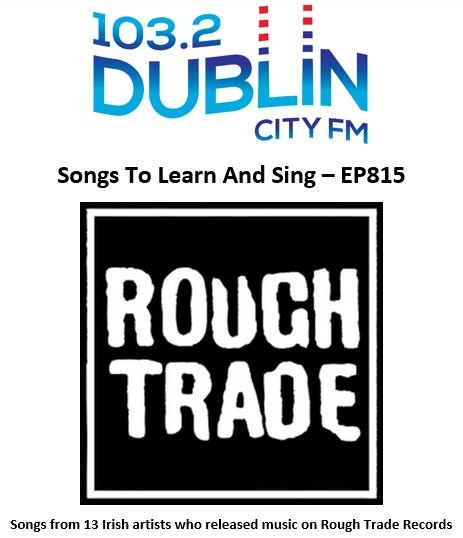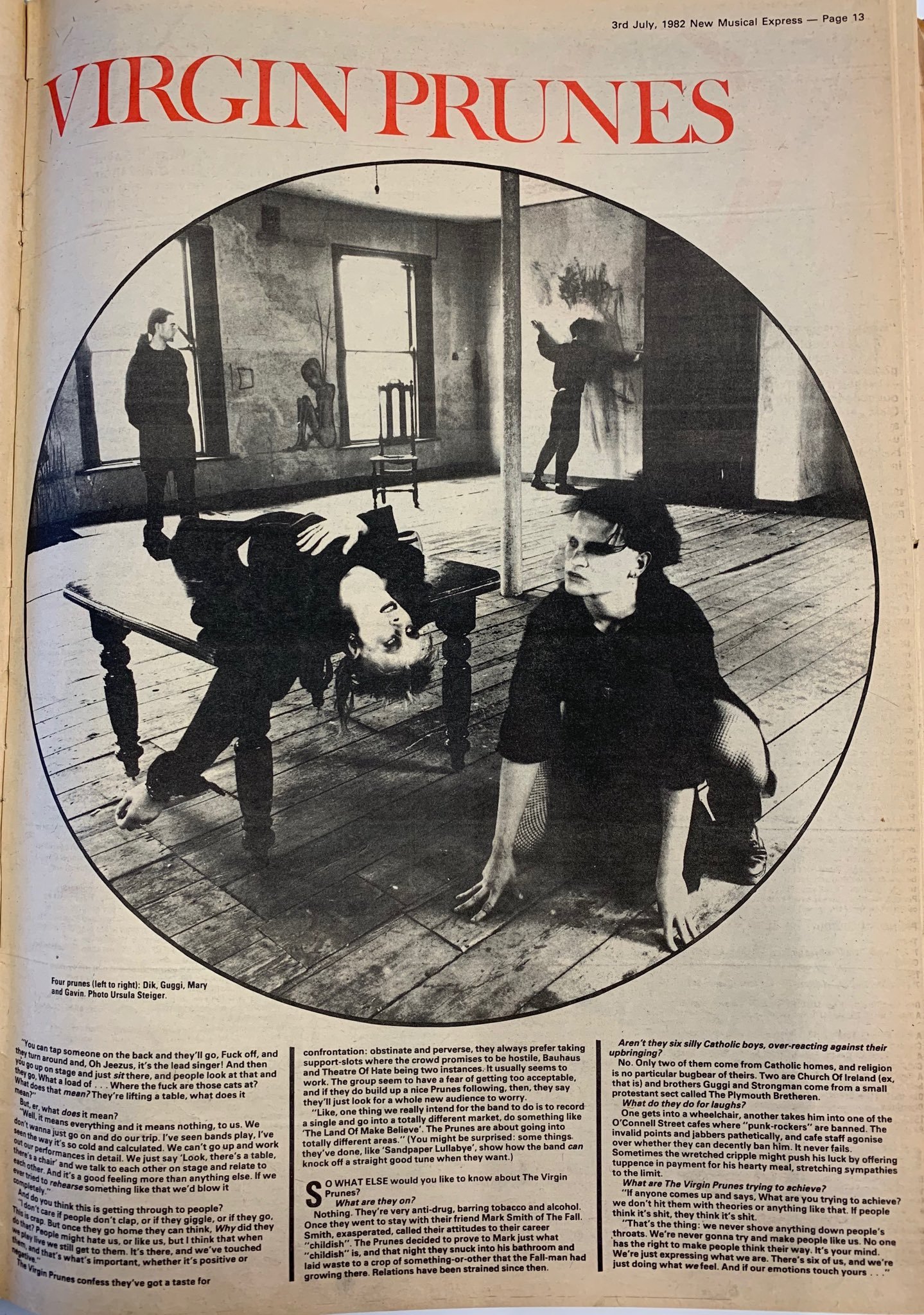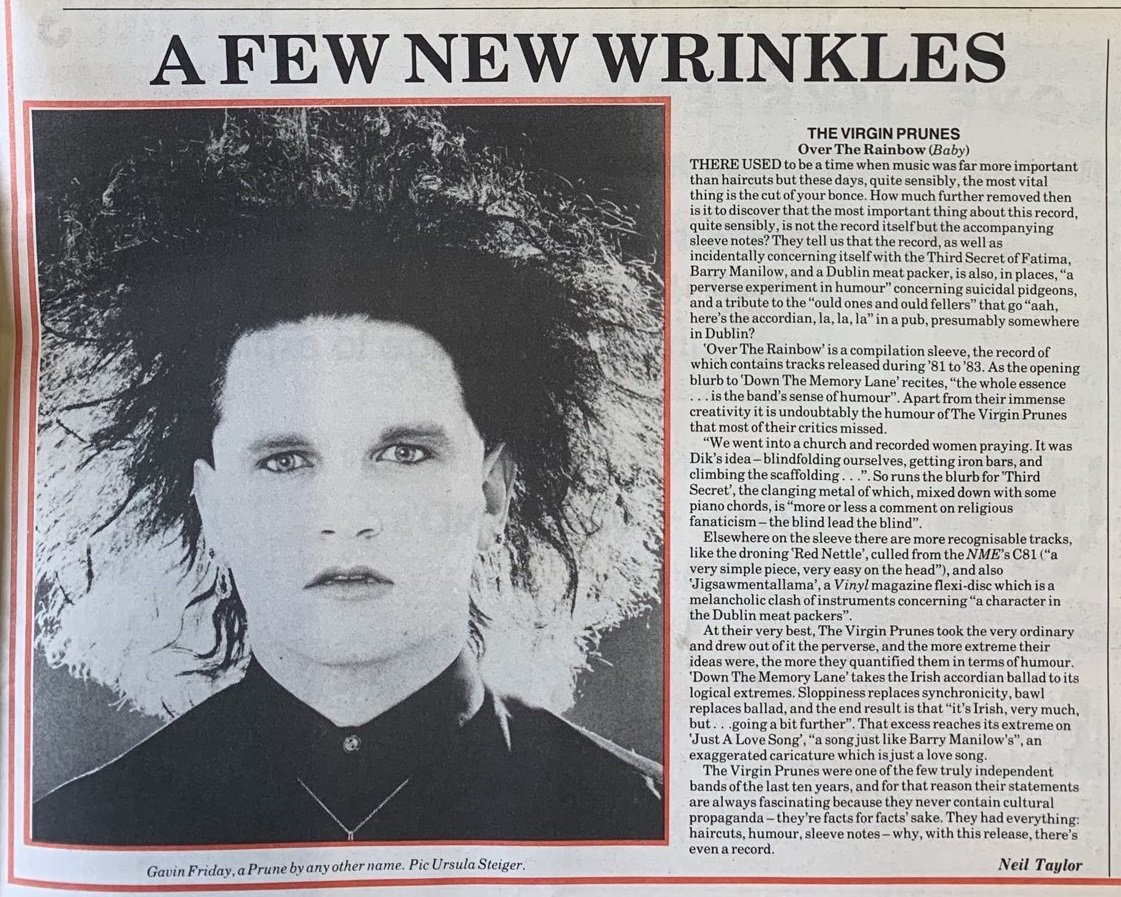Episode 23
…If I Die, I Die
by Virgin Prunes
Episode 23 - Preview
…If I Die, I Die (Rough Trade Records, 1982). “Blue” Side. Photograph by Paul McDermott.
Episode Notes
Episode 23 of To Here Knows When - Great Irish Albums Revisited focuses on …If I Die, I Die by Virgin Prunes
“They were Dublin’s Stones to U2’s clean-cut Beatles image. The guys who’d hang about Grafton St in dresses in the daytime, and spend nights preparing for gigs and atrocity exhibitions. But despite their overt exhibitionism, they were always capable of producing splendidly minimal rock tunes.” Leo Finlay - Select (August 1999)
In this episode Gavin Friday joins me to discuss ...If I Die, I Die by Virgin Prunes. We talk about Dublin in the 1970s and 80s; the band’s A New Form of Beauty multi format releases in 1981; touring throughout Europe; pushing boundaries with performance; working with Wire’s Colin Newman on …If I Die, I Die; Séan Nós (old style) and the other Irish influences on the album; working with the photographer Ursula Steiger on the sleeve art concept; gigs in the UK; the Irish journalist Bill Graham; the band’s Hérésie concept album; producing the band’s last album The Moon Looked Down and Laughed with Soft Cell’s Dave Ball and the ending of the band. We also chat about the latest album that Gavin is currently working on and how proud he is of the Virgin Prunes.
Time is a funny thing – some of the November 1982 reviews in the UK music
press for …If I Die, I Die could at best be described as lukewarm. Fast forward 8 years to the
first reissue of the album and the music press had definitely changed its tune. “They were Dublin’s Stones to U2’s clean-cut Beatles image,” wrote Leo Finlay in his August
1990 retrospective review. I like that line.
A New Form of Beauty
NME Advert - 12/12/1981
In the NME’s 1990 review, Jerry Smith wrote that, “If I Die, I Die stands as a delicious concoction of mysterious depth that vaults from the insistent pop of ‘Baby Turns Blue’ to the poetic sweep of ‘Theme for Thought’ and the dramatically unfathomable ‘Baudachong’.” He continued, “It was the nearest that these rampant art terrorists ever came to capturing the malevolent spirit of their live incarnation.”
This is so completely at odds with Mat Snow’s original NME review of the album published on 27 November 1982. “The Virgin Prunes operate comfortably within current modern rock conventions, and this, their first LP, is an occasionally interesting but largely unremarkable affair,” he wrote.
Most readers will probably know the origins of the Virgin Prunes, mid-70s, Dublin’s Northside, Cedarwood Road, a group of teenagers growing up create their own sanctuary for outsiders, a secretive world that they called the Lypton Village. Fionan Hanvey became Gavin Friday, Paul Hewson became Bono, Dave Evans became The Edge and Derek Rowen became Guggi.
Describing this world, Guggi once told the NME that: “Lypton Village is a village in the head.” He said, “It represents how we got together through this understanding we all had. It’s very real because we bring it into our everyday life. It relates to our values and what we see in other people.”
Virgin Prunes was fronted by Gavin Friday joined by fellow Villagers, Guggi, Dave-id Busaras, Strongman, Dik Evans and Pod. Following Pod’s early departure he was replaced by Ha Lacka Binttii who in turn was replaced by Mary D’Nellon.
In their early days the band abandoned traditional rock ‘n’ roll tropes in favour of performance art, installations and the avant-garde. Early gigs were often staged in performance spaces and galleries rather than pubs and clubs. “We had a platform within the Project Arts Centre to do what you want,” Gavin previously told me. “You didn’t have the pub-rock buying punter that was in the Baggot Inn or in McGonagles.”
Their live shows were legendary confrontational events: audiences were often simultaneously shocked and bemused. Not for nothing did Mark Prendergast, in his book Irish Rock describe the Virgin Prunes as, “the most overtly subversive rock group ever to come out of the genre.”
The Virgin Prunes left Dublin for London in 1979 and then spent the next couple of years gigging throughout Europe where they enjoyed a huge cult following. The band moved to Berlin and was fêted in France, Holland, Belgium, Italy, the Netherlands and Germany.
A few years ago talking about those years Gavin told me, “We got out of London but we didn’t really come back to Dublin because we kept going away. We started gigging seriously outside of the country from 1979 on. The first time we played London was 1979.”
“We would be in Europe for nine or ten months of the year. If you split that up, we’d be home in Dublin for three weeks at Easter, three weeks at Christmas etc. Just running back. We lived in Berlin for two years at one stage coming back and forth. But we got out of London. London we found quite regressive.”
…If I Die, I Die (Rough Trade Records, 1982). “Brown” Side. Photograph by Paul McDermott.
Virgin Prunes released their debut single “Twenty Tens” on their own Baby Records in February 1981. This was followed up with “Moments and Mine” in August. Then in November and December 1981 came the ambitious A New Form of Beauty project. An exhibition at the Douglas Hyde Gallery in Trinity College Dublin and four releases on different formats – a 7”, a 10”, a 12” and a cassette. With “Red Nettle” the band also contributed one of the standout tracks to C81, the NME’s influential compilation tape.
Though loved in Europe the UK music press of the day had a real love/hate relationship with the band. Articles about the band were sometimes positive but more often downright negative — indeed many were vitriolic, caustic, simply nasty or indeed sometimes laced with an anti-Irish sentiment.
The Faculties of a Broken Heart (12” Rough Trade Records, 1982). Photograph by Paul McDermott.
“The Virgin Prunes are Irish. This has got nothing whatsoever to do with the comically inept state of their performance art, but it might explain the presence of a partisan audience largely consisting of Irish exiles prepared to put up with their nonsense.” Chris Boyn (NME)
“The first time I saw the Prunes I couldn’t tell if their vocalists were male or female, because of their dresses and the bad lighting, but the lighting was bright this time and I managed to see how ugly they are.” Caroline Harper (Melody Maker)
“Whereas U2 are cleancut and direct, the Prunes attempt to intrigue and mystify with a shambolic pretence of spontaneity and a clutter of Gothic-horror props.” Mat Snow (NME)
Helen Fitzgerald, who had written for Vox magazine back in Dublin before moving to London in 1981 seemed to get the Virgin Prunes, reviewing a gig in the NME, she declared, “The Prunes were spectacular as always.”
“They were never less than brilliant. Gavin and Guggi were in fine fettle, mixing and juxtaposing old and new in an aggressively lucid conglomeration of bizarre imagery and teasing challenges.”
What came next for the band? Wire’s Colin Newman was hired as producer and the band decamped to Windmill Lane in mid-1982 to produce …If I Die, I Die. Rather than adopting a conventional A-Side/B-Side format, the sides of the record were given brown and blue colours, signalling earth and fire respectively, or primitive and then urban.
The music on each side reflected these moods. Vox magazine at the time described it as: “a mythical side which is soft, acoustic and extremely sensitive. And it has a typical Prunes side – heavy on the head, and deeply rooted in worldly affairs.”
Producer Colin Newman was interviewed in the same issue of Vox and stated that, “with the Prunes I have attempted to organise them so that they would deliver their best. It’s going to be a very well-produced album.” And he was right - it was a brilliant sounding album.
My old friend Jim O’Mahony, has a framed poster in his living room of a gig that was held on 28 Oct 1982 in McGonagles, Dublin. It was billed as “Virgin Prunes Say goodbye”. Now I’ve often heard Jim say that this was his favourite gig of all time so I asked him if he’d write a few words to explain why…
Photograph by Jim O’Mahony.
“Virgin Prunes Say Goodbye”
McGonagles, Dublin - Thursday 28 October 1982
By Jim O’Mahony
“I was living in Dublin at the time and was listening to them a lot. I used to walk around the no go areas of the inner city listening to Virgin Prunes bootlegs on my Walkman and it was a great way to really hear them. The gig was just after the A New Form Of Beauty 1-4 which musically was their best period. They didn't really do gigs - they gave performances. Individually they all had great presence onstage in particular Gavin, Guggi and Dave ID - who usually opened the show. People tended not to get too near the stage as they were also quite scary.
The performances were hugely theatrical and quite often shocking. They pushed serious boundaries regarding gender that no other band was doing. The setlist was mainly the songs that would end up on the album but much rawer and a bit dirtier live. I hate the production on the album. It doesn't sound like them.
I think this gig was them changing direction musically, visually and artistically, hence the “Say Goodbye” tag. Their live shows changed after this. The Heresie boxset gives a good indication of what they sounded like and there's some excellent footage on YouTube. We managed to get backstage after the gig and chatted to Dave ID for ages but the rest of them were all arguing with each other. I went into Freebird the following morning and stole the poster which is framed on my wall here at home.
The best Irish band I've certainly ever seen live and it was a privilege to be one of the lucky ones to witness this incredible and unique performance.”
For Further Listening/Reading:
To Here Knows When column in The Goo on If I Die, I Die…
by Paul McDermott
The Goo - Issue 07 (Dec-Jan 2022)
Virgin Prunes are one of thirteen Irish artists who have had their music released by Rough Trade Records (not counting the sub-label River Lea). In 2021 I broadcast an episode of my radio show Songs To Learn And Sing which focused on all thirteen artists, you can listen back to it below.
Rough Trade Ireland
Girl Band – Pears for Lunch (2015)
Virgin Prunes – Baby Turns Blue (1982)
David Kitt – Sleep Comes Tomorrow (2000)
SOAK – B a Nobody (2014)
Princess Tinymeat – Angels in Pain (1986)
Puppy Love Bomb – I’m Not Listening (1994)
Hal – Play the Hits (2004)
Microdisney – Dolly (1984)
The Stars of Heaven – Never Saw You (1987)
Daniel Figgis – Alison Creaking (1995)
Cara Dillon – Black is the Colour (2001)
Lankum – The Dark Eyed Gypsy (2019)
Stiff Little Fingers – Rough Trade (1979)
I previously interviewed Gavin Friday in March 2019. He had agreed to contribute to my radio documentary No Journeys End — the story of Michael O’Shea and I also wanted to talk to him for the liner notes I was writing for Hiding From the Landlord the compilation of Finbarr Donnelly and his bands Nun Attax/Five Go Down to the Sea?/Beethoven. The interview was broadcast as an episode of my radio show Songs To Learn And Sing in August 2021. In the interview we touch on a lot of subjects not covered in this episode of To Here Knows When: the early days of the Virgin Prunes, the influence of David Bowie, Dublin's Project Arts Centre, post-punk philosophies, The Fall, Vox magazine, Michael O'Shea, Five Go Down to the Sea?'s Finbarr Donnelly, PIL, the NME's C81 cassette, My Bloody Valentine, Cathal Coughlan, and London. Listen to the full interview below:
That 2019 interview also forms the text of an oral history:
Gavin Friday on: Virgin Prunes, David Bowie, Dublin’s Project Arts Centre, post-punk philosophies, The Fall, Vox magazine, PIL, the NME’s C81 cassette, My Bloody Valentine, Cathal Coughlan, and London.
5,100 words (20 minute read)
The clip I play Gavin is taken from a 1984 interview broadcast on Radio SWK, a radio station in St Etienne, France.
The full interview can be heard on the Radio SWK Archives. The site also has a great archive of Virgin Prunes photographs and video footage from 1984.
…If I Die, I Die - 40th Anniversary Edition (BMG Records, 2022). Photograph by Paul McDermott.
Finally, below is a selection of Virgin Prunes press cuttings from various music magazines including NME, Melody Maker, Select, Record Mirror and Music Week. (Sources include: @nothingelseon and Select magazine scans)
Music Week (11/07/1981)
NME (12/12/1981)
NME (19/12/1981)
NME (23/01/1982)
Melody Maker (27/12/1982)
NME (03'07/1982) - Part 1
NME (03'07/1982) - Part 2
Melody Maker (06/11/1982)
Melody Maker (13/11/1982)
NME (27/11/1982)
NME (04/12/1982)
NME (14/05/1983)
Melody Maker, (20/08/1983)
NME (20/08/1983)
NME (27/04/1985)
NME (1986)
NME (18/01/1986)
Music Week (14/06/1986)
Music Week (21/06/1986)
NME (26/07/1986)
Music Week (02/08/1986)
NME (05/04/1988)
NME (23/06/1990)
Select (August, 1990)



































